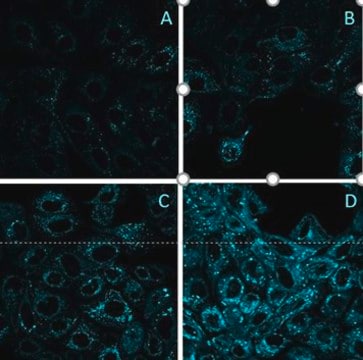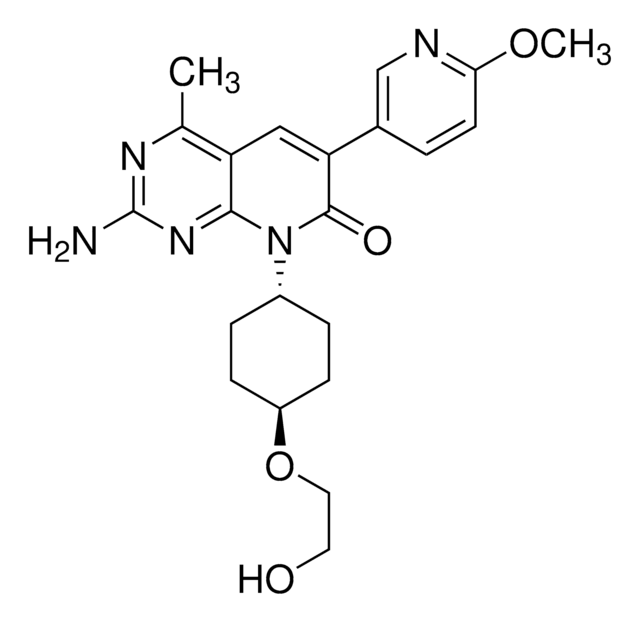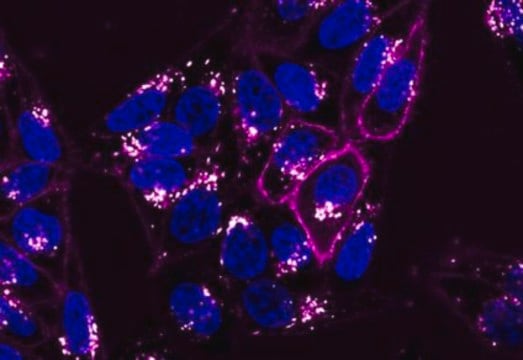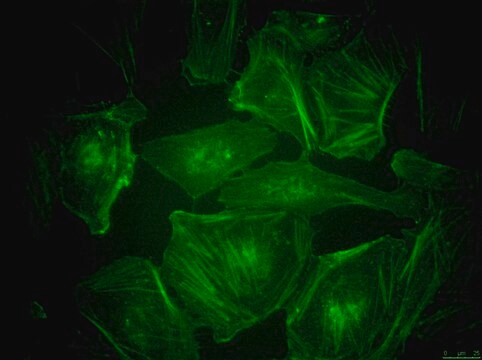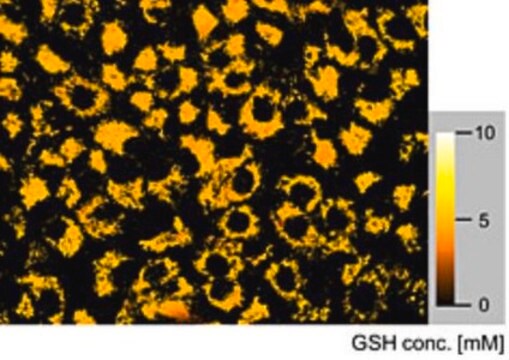推薦產品
化驗
≥98% (HPLC)
形狀
lyophilized
分子量
calculated mol wt 1080.94
包裝
pkg of 1 mg
製造商/商標名
Millipore
儲存條件
desiccated
protect from light
技術
cell based assay: suitable
顏色
off-white
檢測方法
fluorometric
運輸包裝
ambient
儲存溫度
−20°C
一般說明
Hypochlorite (HClO/ClO-) is a reactive oxygen species (ROS) produced by the enzyme myeloperoxidase (MPO), which catalyzes the reaction of hydrogen peroxide (H2O2) and chloride ion (Cl-), and plays an important role in the immune response to defend against invading pathogens. Excessive generation of hypochlorite could lead to oxidative stress, which causes inflammation and can lead to a range of diseases, including cardiovascular diseases, atherosclerosis, osteoarthritis, neuron degeneration and cancers.
BioTracker Rd1 Hypochlorite Live Cell Dye is a mitochondria-immobilized turn-on green fluorescent probe for the selective detection of hypochlorite (ClO-). The probe contains a benzoyl acetohydrazide linking site for ClO- recognition, a triphenylphosphonium group for mitochondria targeting, and a reactive methoxymaleimide subunit for mitochondrial fixation. The targeting and fixed properties of the probe enable it to accumulate in mitochondria and prevents leakage of the dye upon the decrease of mitochondrial membrane potential (MMP). This probe may be used to visualize exogenous and endogenous ClO- levels in living cells, tissues, and zebrafish.
Reference:
1. Li, M. Y., et. al. (2020). Mitochondria-Immobilized Fluorescent Probe for the Detection of Hypochlorite in Living Cells, Tissues, and Zebrafishes. Analytical chemistry, 92(4), 3262-3269.
BioTracker Rd1 Hypochlorite Live Cell Dye is a mitochondria-immobilized turn-on green fluorescent probe for the selective detection of hypochlorite (ClO-). The probe contains a benzoyl acetohydrazide linking site for ClO- recognition, a triphenylphosphonium group for mitochondria targeting, and a reactive methoxymaleimide subunit for mitochondrial fixation. The targeting and fixed properties of the probe enable it to accumulate in mitochondria and prevents leakage of the dye upon the decrease of mitochondrial membrane potential (MMP). This probe may be used to visualize exogenous and endogenous ClO- levels in living cells, tissues, and zebrafish.
Reference:
1. Li, M. Y., et. al. (2020). Mitochondria-Immobilized Fluorescent Probe for the Detection of Hypochlorite in Living Cells, Tissues, and Zebrafishes. Analytical chemistry, 92(4), 3262-3269.
應用
Purity ≥ 98% confirmed by HPLC. Identification confirmed by HNMR, LC-MS, and elemental analysis.
特點和優勢
Mitochondria-immobilized turn-on green fluorescent probe for the selective detection of hypochlorite.
外觀
Lyophilized. Off-white solid.
儲存和穩定性
Store at -20°C, desiccate and protect from light
Note: Centrifuge vial briefly to collect contents at bottom of vial before opening
Note: Centrifuge vial briefly to collect contents at bottom of vial before opening
其他說明
Live cell fluorescent imaging
免責聲明
Unless otherwise stated in our catalog or other company documentation accompanying the product(s), our products are intended for research use only and are not to be used for any other purpose, which includes but is not limited to, unauthorized commercial uses, in vitro diagnostic uses, ex vivo or in vivo therapeutic uses or any type of consumption or application to humans or animals.
儲存類別代碼
11 - Combustible Solids
水污染物質分類(WGK)
WGK 3
閃點(°F)
Not applicable
閃點(°C)
Not applicable
分析證明 (COA)
輸入產品批次/批號來搜索 分析證明 (COA)。在產品’s標籤上找到批次和批號,寫有 ‘Lot’或‘Batch’.。
Meng-Yang Li et al.
Analytical chemistry, 92(4), 3262-3269 (2020-01-21)
A mitochondria targeting and immobilized fluorescent probe (Rd1) using triphenylphosphonium as the targeting group and methoxymaleimide as the fixed site is designed for the detection of ClO-. The methoxymaleimide fixed group can react with nucleophiles, such as the reactive thiol
我們的科學家團隊在所有研究領域都有豐富的經驗,包括生命科學、材料科學、化學合成、色譜、分析等.
聯絡技術服務